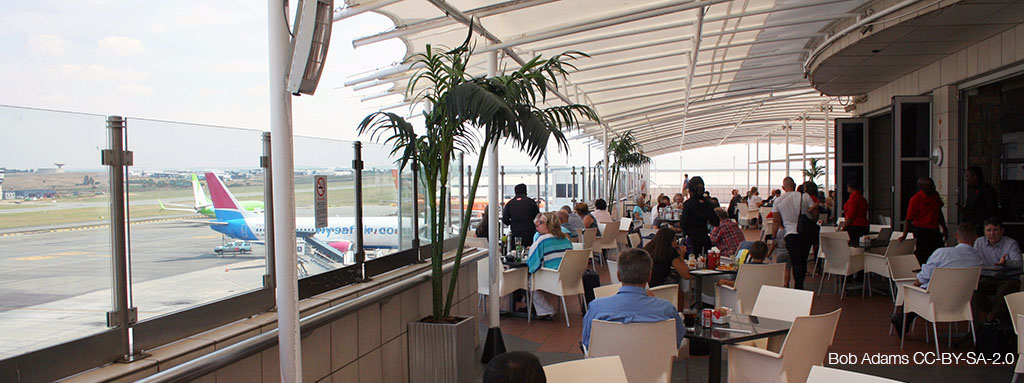
Looking back, it is surprising how many changes there have been in airports in just over a century of commercial aviation. And it’s not just the types of aircraft, or the design and size of the terminals, but also other aspects directly related to the passenger.
The gourmet gastronomic experience is becoming increasingly important to the passenger experience.
Until almost the end of the 20th century, aviation was considered somewhat elitist, since it was an expensive and exclusive means of transport. Currently, it is still an exclusive experience for those who want to pay for a first class ticket, but nowadays everyone can access flights at very affordable prices. This has led to a sustained increase in the number of passengers using airports, particularly in the last twenty years, and this shows no signs of changing – rather the contrary.
Passengers are also spending more time at airports. The security measures imposed in recent years have compelled earlier check in times and, consequently, longer stays in the terminal. And what has been the most direct consequence? Without doubt, the increase in leisure services, shopping and dining on offer at airports, all aimed at improving the passenger experience.
It seems a logical equation from the commercial point of view: more passengers, for a longer period of time and in a limited space.
Catering has been a constant in terminals, but, for the reasons set out above, airport managers have seen an opportunity to capture, not only the traveller that is happy to make do with a hamburger and a drink, but also those that are looking for a more glamorous gastronomic experience. They have come to realise that a large number of passengers want good food and are willing to pay for it. Let’s look at a few examples that can already be seen in airports:
At Orlando Airport (MCO), in Florida, you can find the Cask & Larder restaurant, which created a real revolution by incorporating the “farm to terminal” concept. After it opened, the airport saw an increase of 24% in catering services, which exceeded by a large margin the 7% increase seen in passenger traffic. Its secret is to offer fresh, quality products, as well as the best regional dishes.
In the same airport, you can find other out-of-the-ordinary restaurants, such as “Bahama Breeze”, “MCO Market” and “Taco Loco”. This is exactly what today’s passengers are looking for.
In the case of Atlanta’s Hartsfield-Jackson International Airport (ATL), there is the curious case of “One Flew South”, a luxury gastronomic experience that promotes partnership with farmers and local producers. It also offers large dishes to take away.
At El Prat-Barcelona Airport (BCN), the “Porta Gaig” restaurant can be found, chosen by the Daily Mail as the best airport restaurant in the world thanks to an extraordinary selection of regional Catalan dishes, updated and reinvented by the prestigious chef Carles Gaig.
Without doubt, one of the attractions of Terminal 5, at London’s Heathrow Airport (LHR), is “Plane Food”, the restaurant managed by the famous international chef Gordon Ramsay. Because this is one of the world’s busiest airports in terms of international traffic, the restaurant has opted for high quality European cuisine in an environment with modernist décor.
The chef Dani García has the “DeliBar” restaurant at Malaga-Costa del Sol Airport (AGP), which stands out for its offer of typical, popular Andalusian tapas, to which he gives a modern touch.
At Canada’s Toronto-Pearson Airport (YYZ), the Canadian chef Roger Mooking’s “Twist” stands out for its offer of good quality North American home-style food. There are other restaurants at the same airport, and although perhaps regional cuisine is not their strongest point, they are among the most prestigious in the world. These are “Asian Kitchen” from the chef Susur Lee and the “Boccone Trattoria”, from the famed chef Massimo Capra.
Munich Airport (MUC) has recently received awards for having the best restaurants, but if it stands out for any one thing in particular, it is for being the only airport with a brewery, called “Airbräu”, with its corresponding eatery featuring regional dishes. There is no doubt that Bavarian beer is a regional product of fame and prestige.
At Hong Kong Airport (HKG), “Hung’s Delicacies” is a highlight – a high-quality eatery where the regional cuisine has an important role to play and where marinated meats are a benchmark.
This selection would not be complete without a mention of the restaurant “Top Air”, at Stuttgart Airport (STU). This was one of the first to launch this trend, where chef Marco Akuzun offers a selection of gourmet European dishes in which excellent meat predominates.
The complete list is much longer, and every day there are more airports joining the trend, opening top rate gastronomic spaces in their facilities.
Fast food, for its part, has not ceased to have its followers and, therefore, the main chains maintain their presence at airports. But a high percentage of passengers are specifically looking for a gourmet experience with typical, authentic dishes from the places where they are travelling. And airport managers know it.
Enjoy your meal!

